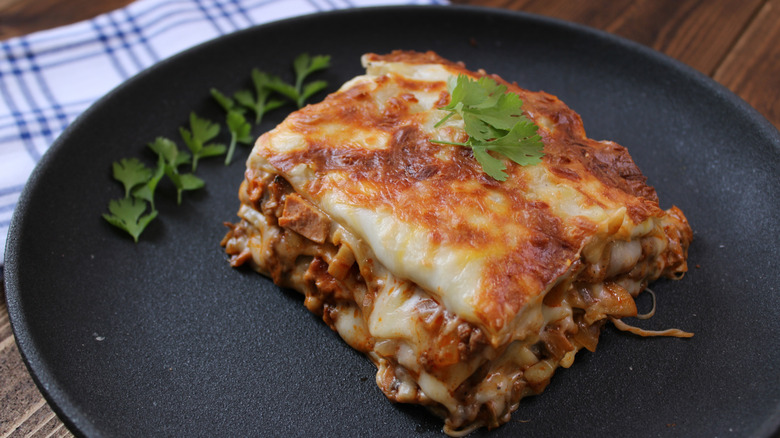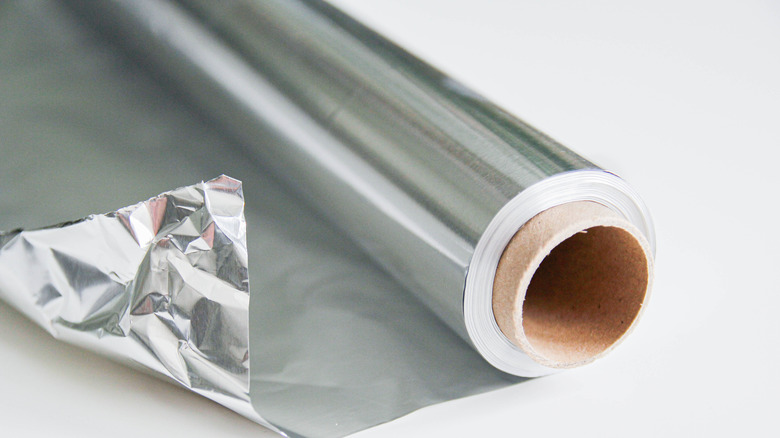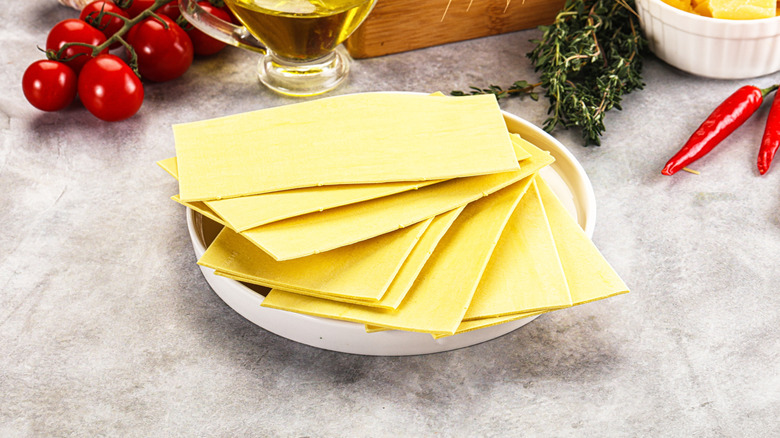Why Aluminum Foil Is The Secret To A Perfectly Baked Lasagna
Lasagna is one of those things that's either done right or it's a complete and utter disaster — there is no in-between. But if done right, it's the perfect comforting dish, with sophisticated flavors cascading down layers of gooey goodness. But how can we prevent the lasagna's edges from baking too quickly, the top from getting too crisp, or the center from being cooked unevenly? While you can follow Giada De Laurentiis' sheet pan technique for crispy lasagna noodle edges (shorter noodles instead of full noodles), there's another unassuming hero in this story: aluminum foil.
Covering your lasagna with foil guarantees that it cooks evenly while keeping the all-too-important top from drying out. This is a common mistake that people make when cooking lasagna, and it's crucial to avoid, because no one wants a shriveled-up lasagna with a curled-up and burnt top and rubbery tastes. Just, no.
Foil holds in the moisture and cooks its layers thoroughly. And here's where you get the best of both worlds: You achieve both even cooking and that tantalizingly crispy top layer of irresistible cheese. The good news is that this technique works with both homemade pasta and store-bought sheets, so you can make perfectly baked lasagna every time.
The science of timing and layering
Cooking time for lasagna depends on its thickness and the number of layers. Some people go for that "wow" factor and stack their lasagna with something like six layers. Call me basic, but a standard lasagna with three or four layers suits me just fine, so that's the metric I'll use here. Obviously, you have to adjust a bit if you're baking a thicker, multilayered tower of lasagna.
For the first half of the cooking process, keep the foil snug around the baking dish. This creates a steamy environment, softening the pasta and melding the flavors of the sauce, cheese, and fillings. If you're using store-bought dry pasta sheets, this step is especially critical to ensure they cook properly.
Without the foil, the top can harden before the interior layers are cooked through, leaving you with an uneven texture. Keep an eye on your lasagna during the last minutes after the foil comes off, because every oven is a little different and you don't want the top to burn.
Tips for working with store-bought pasta sheets
Using store-bought pasta sheets is convenient, but they require a little more attention when cooking for the best results. Many prepackaged lasagna noodles are labeled as "oven-ready" or "no-boil," meaning they don't need to be pre-boiled prior to assembling your lasagna. However, this can also lead to undercooked edges. When using these pasta sheets, make sure to fully cover the layers with sauce to ensure the pasta absorbs enough moisture while baking; this also solves the problem of runny homemade lasagna sauce.
Covering the lasagna with foil during the first part of the bake also helps store-bought noodles cook evenly. If you're layering multiple sheets, try not to overlap too much, as this can create uneven textures. Again, the process isn't too much different from making the pasta sheets yourself, but you do have to add a few extra steps and tweak things slightly to get the same results as fresh pasta.
I have a responsibility to convey this, because I don't want folks coming after me because they didn't add enough sauce to store-bought sheets and their lasagna came out dry Just remember: Whether it's homemade or store-bought, aluminum foil is your best friend in ensuring every layer bakes to perfection. And remember: It's perfectly safe to reuse aluminum foil.


